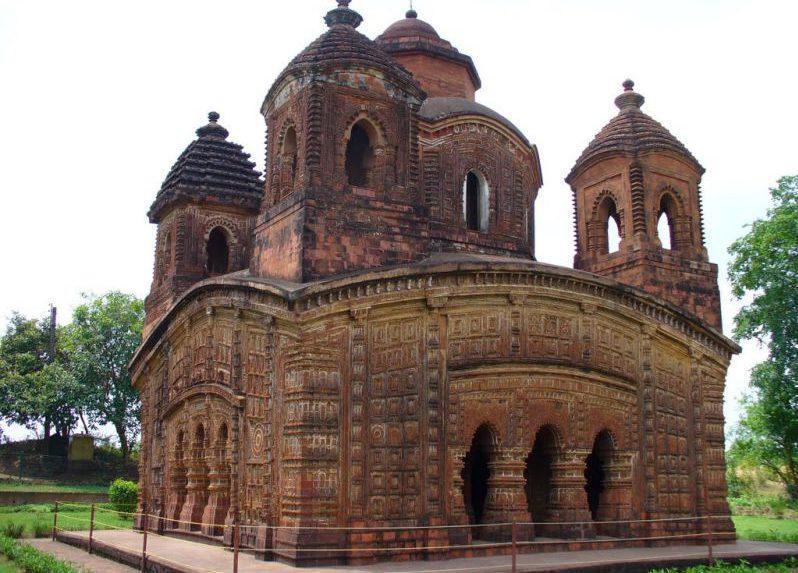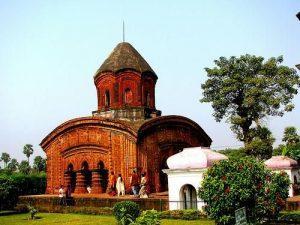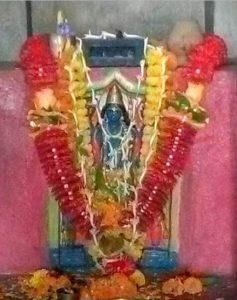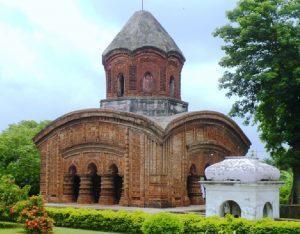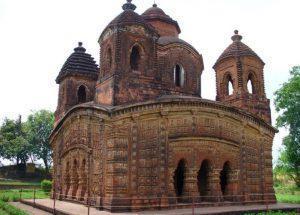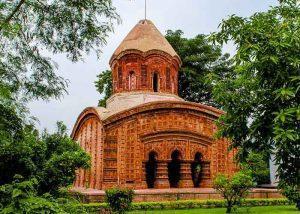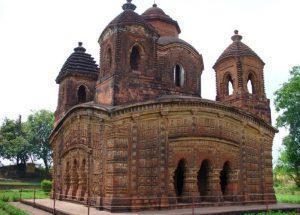Ananta Basudeba Temple, Hooghly, West Bengal
| Date built: | – |
|---|---|
| Deity: | Lord Krishna |
| Architectural style: | – |
| Major festivals | – |
| Locale: | Akkalkot |
| District:: | Hooghly |
| Address: | Bansberia, Mithapukur More, West Bengal 712502 |
| Phone | – |
Ananta Basudeba temple is a temple of Lord Krishna in the Hangseshwari temple complex in Banshberia, in the Hooghly District in the Indian state of West Bengal. Built by Raja Rameswar Datta in 1679, this temple is noted for the exquisite terra cotta works on its walls. It is built in the traditional eka-ratna style, with curved cornices. The tower on top of the temple is octagonal. The terracota works depict stories from the great Indian epics Ramayana and Mahabharata, as well as from lilas of Krishna.
Architecture
Ananta Vasudeva temple is another famous temple of Bansberia that represents traditional ‘Ekaratna’ style of architecture. The temple has curved cornices, triple arched entrance and an octagonal tower. The presiding deity of the temple is Lord Krishna. Intricate terracotta carving on the walls of the temple showcases scenes of love, war, everyday life and Gods. Built in 1649, it is located in the premises of Hangeshwari temple. It was constructed by Raja Rameshwar Datta who was a strong follower of Vaishnavism. The architecture and artistry of the temple have a stark resemblance with the terracotta temples of Bishnupur. Besides the temple, the remains of Dattaroy Palace are also located here. Fragments of arches and broken walls of the palace are still found around Ananta Vasudeva temple.
Anant Vasudeva temple and Hangeshwari temple are the major tourist attractions of Bansberia. The temple edifices are embellished with elaborate and exquisite terracotta carvings. Ananta Basudeba temple is a temple of Lord Krishna in the Hangseshwari temple complex. This temple is noted for the exquisite terra cotta works on its walls. It is built in the traditional ekaratna style, with curved cornices. The tower on top of the temple is octagonal. The terracotta works depict stories from the great Indian epics Ramayana and Mahabharata, as well as from divine works of Krishna.
The terra cotta works on buildings were a new style in the 17th century and the Anant Vasudeva temple was a fine example of it during that period. The temple inspired many craftsmen during that period and similar structures including temples were builtin nearby areas. The Ramachandra temple built in Gupti Para is an example of this. The terra cotta work became a symbol of Bengal architecture during this period and contributed to the extreme popularity of the Anant Vasudeva Temple during this period.
Legend / Local stories
n 1656, the Mughal emperor appointed Raghab Dattaroy of Patuli as the zamindar of an area that includes the present-day Bansberia. Legend has it that Raghab’s son Rameshwar cleared a bamboo grove to build a fort, inspiring the name Bansberia.
The Ananta Basudeba temple was constructed by Rameshwar Datta, an ardent follower of Vaishnavism, in 1679. Three sides of the one-storeyed temple are decorated with richly carved terracotta panels. The turret also contains terracotta carvings. Its decorative scheme is similar to that of the terracotta temples, situated in Bishnupur. Bansberia’s importance in pre-Muslim Bengal was religious, owing to its location at the Tribeni or confluence of three rivers (Ganga, Jamuna, and Saraswati). After Muslim occupation in the late 13th century, it continued to be an important city under the Tughlaks, as a military base, mint-town and port. After the Mughal conquest of Bengal in the mid-16th century, the city started to decline due to the loss of royal patronage, but some areas such as Bansberia continued to prosper up to the 19th century.
Photo Gallery
How to Reach:
By Road: The temple present in Bansberia district. We can reach the Temple easily by hiring auto, bus or taxi from anywhere in the Kolkata state or from neighboring state. Kolkata is connected with most of the Indian cities by road. The National Highway number 2 and 6 connect the city with other cities and states in India. Kolkata has a broad network of government and private buses. The Calcutta State Transport Corporation (CSTC), Calcutta Tramways Company (CTC) and West Bengal Surface Transport Corporation (WBSTC) run regulars bus service in the city. The Esplanade Terminus in the heart of the city is the main bus terminus.
By Rail: The nearest Railway Station to the temple is Howrah which is 49 km from the temple
By Air: The Temple can be reached through nearest Netaji Subhas Chandra Bose International Airport(40 km) which is well connected with regular domestic flights to Delhi, Mumbai.
Contact Details
Official Address

